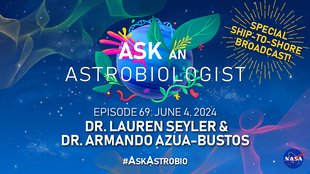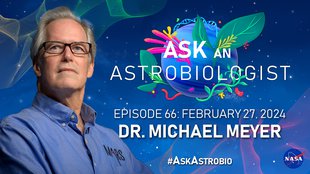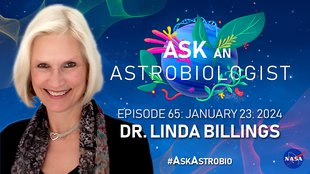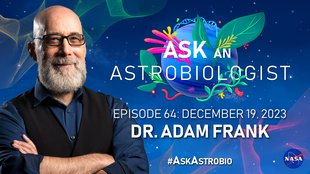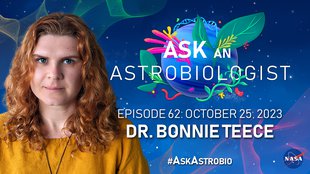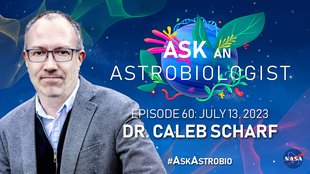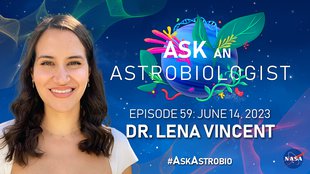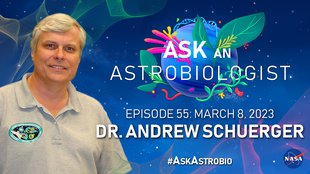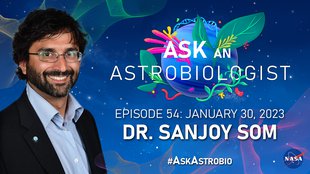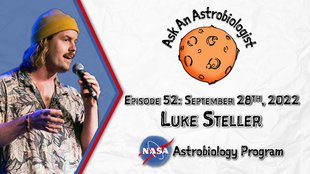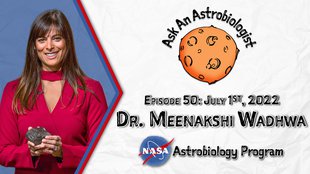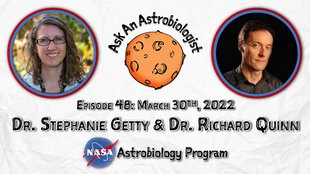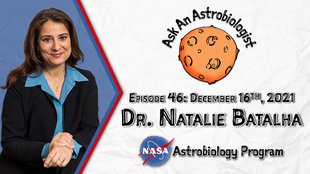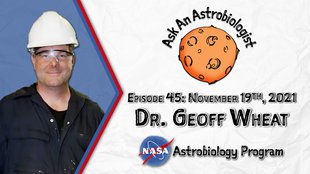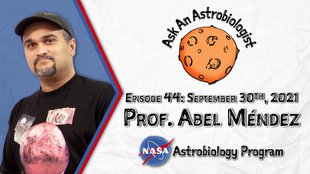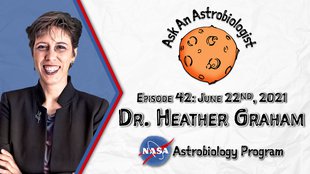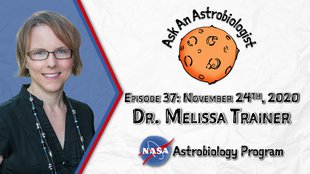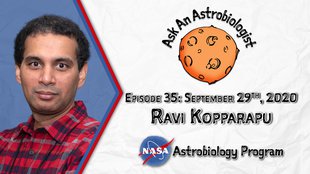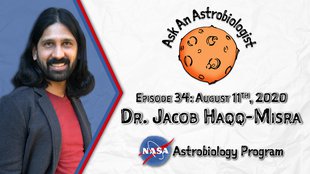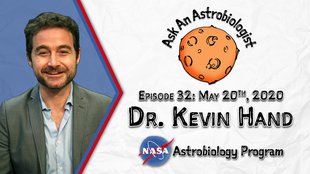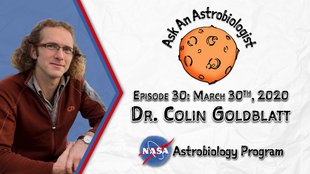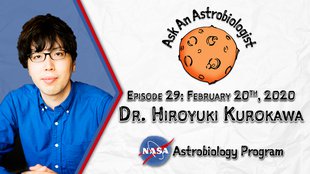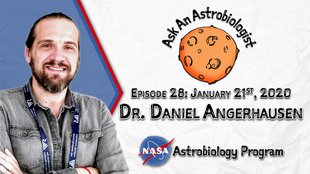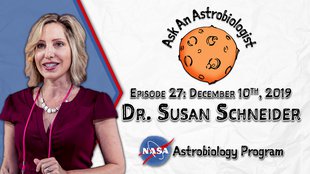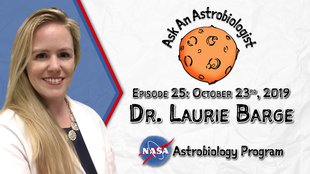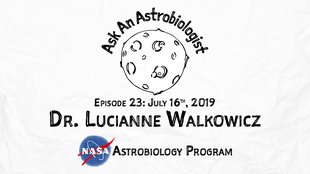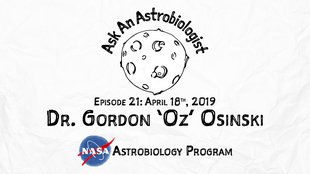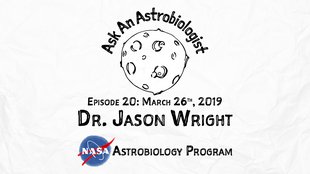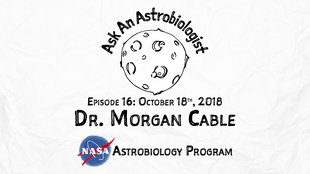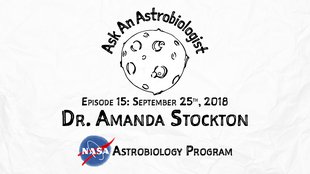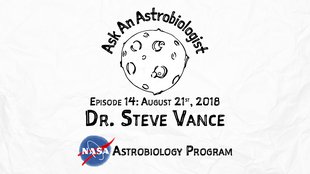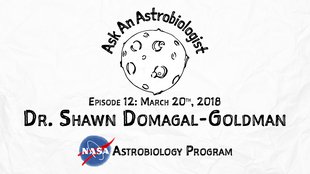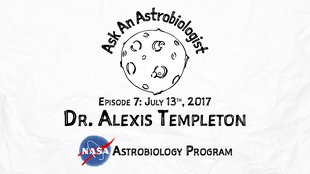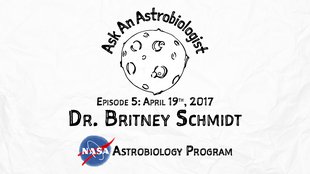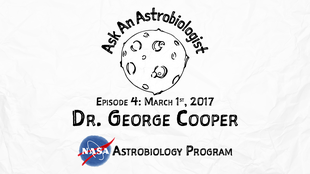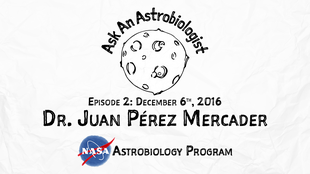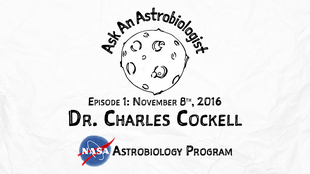
We welcome to SAGANet, Dr. Eric Boyd, Assistant Professor of Microbiology and Immunology at Montana State University! Dr. Boyd is an expert in extremophiles and hot spring microbiology.
You can find out more about his work here.
Greetings, friends of astrobiology. Welcome back to a brand new episode of Ask an Astrobiologist. My name is Sanjoy Som, and this show is made possible by contributions from the NASA astrobiology program, ELSI, the Earth-Life Science Institute at Tokyo Tech, and the nonprofit Blue Marble Space. This month, we have a special guest again. It is Dr. Eric Boyd of Montana State University, but first, here is your monthly background quiz.
Other Recent Episodes
Ocean World Science Aboard the Ship 'Falkor Too' with Drs. Lauren Seyler & Armando Azua-Bustos
The Art of How to Become an Astrobiologist with Dr. Aaron Gronstal
How & When Do Molecules Become Life with Dr. Henderson "Jim" Cleaves
What is behind me this month? It's a fantastic site and tells a lot or not much about potential life on the early Earth. Mike, if you could put up the picture from last month, which was the background when we talked last month, it is ... Did anybody guess it right? If you did, you have five seconds to put it on hashtag #askastrobio. It is the site of Cuatro Cienegas in Mexico. It's a pretty cool site, because it hosts in those springs microbial mats. There's actually living mats of bacteria stacked on top of each other. They form some of the modern analogs of very ancient life on Earth. Studying them in extreme environments on Earth can give us a picture of what life was like in its infancy on Earth, and who knows, potentially elsewhere.
If you have any questions during this show, make sure you ask them on either the SAGANet chat or use hashtag #askastrobio on Twitter. Keep a good site of this background behind me, and we will talk about it next month when we chat with our new guest. This month, we welcome Dr. Eric Boyd from Montana State. Hello, Eric. How are you today?
Hello, Sanjoy. Thanks for inviting me along.
We're very lucky to have you. Thank you for being here. We know you're a busy guy, and often you're in the field doing cool stuff. We'll talk about that, but first, like we do to do in this show is turn back the wheels of time a little bit. Can you perhaps describe to us a little bit how you got decided in science in the first place, for some of our younger viewers?
I think that's a really good question, Sanjoy, one that I think is really important for a lot of you younger viewers to hear. Sometimes our paths are fortuitous, aren't they? I grew up in Des Moines, Iowa. I think I got started interested in science at a very young age. My mom and dad made sure that we explored the outdoors any chance that we could get, but it was really a class in Earth sciences in seventh grade that got me really excited about geology. I didn't get interested in microbiology until much later, but that class of geology, studying concepts like plate tectonics and unconformity, how is the Earth working, how can we date rocks in a very basic way, and so on and so forth, that really got me excited about science.
From there, I was fortunate enough to go to Iowa State University and obtain a degree in biology, but it was not a degree in biology that got me really excited. It was working in the labs of several microbiologists, in particular a gentleman named Alan DiSpirito, who's a professor of microbial physiology at Iowa State University. Working in his lab, he really opened up a lot of doors for me, let me explore microbiology in a way that I haven't been able to do until I got my own lab.
From there, there was an individual from Montana State that came out and gave a seminar at Iowa State, a gentleman by the name of Bill Costerton, who was the director of the Center for Biofilm Engineering here at Montana State. He showed me all of these images of microbial mats living in hot springs, and ever since that point, I was bent on coming to Montana State and studying hot springs and life that lives in those hot springs.
Very cool. I want to chat a little bit about your professor at Iowa State. You mentioned you worked in his lab. How did you reach out to him? How do you find him? What was the process of starting to work in a lab?
I worked in several labs as an undergraduate. I worked in a structural biology lab. My first lab experience was as a freshman, my first semester. I was in the honors program at Iowa State University, and they really promoted attaining undergraduate research experience. I'm very grateful for that. I worked in the lab of Amy Andreotti. We studied this protein that, not to get down into the weeds and details, but just how it functioned. How did structure equate to function at a protein, at an enzymatic level? I was excited about that research.
The summer after my sophomore year in college, I decided to go to the Rocky Mountain Biological Lab out in Crested Butte, Colorado, just for a different experience, and started studying wetlands ecology and glaciology were the two classes I took out there, and really started getting more excited about the environmental side of biology, and came back to Iowa State. The way I got into Alan DiSpirito's lab is interesting. My older brother Jeff, who's a professor out at Rutgers University, was actually working in his lab. My in, the way that I got in in Al's lab, completely grateful for it, was through my older brother's experience. I started in studying microorganisms that oxidize methane gas, and just fell in love with that process, and of course microbial diversity from thereon.
You're a microbiologist studying microbes in extreme environments and a diverse set of settings and a diverse set of bacteria. How does that fit into your interest in astrobiology?
Another great question. What is astrobiology? It's studying how life originated on Earth, what life is today on Earth, and then searching for life on other planets, in a nutshell I think. You could call that astrobiology. If you're going to understand how life originated, you'd better have a good perspective on what life looks like now. If you're going to identify what life might look like on another planet, you better have a good perspective on what life looks like in diverse environmental settings here on Earth.
Then of course you can use this information. There's a lot of scientists that believe that life originated in a hot environment, something like 3.8 billion years ago. It's not a stretch to suggest that hot springs represent modern analogs of what an early Earth hot environment might look like. It turns out, when we look at life in these hot spring environments, we see very ancient lineages of microorganisms, microorganisms that when we look at their evolution history, branch very early. We look at humans, and all the animals and plants that we see with our naked eyes, those branched very recently. Those are recent evolutionary adaptations. What we're talking about are microbial lineages that diverged somewhere around 3.5-3.8 billion years ago. We think we're on pretty solid footing looking at life's origins in modern extreme environments like hot springs.
Cool. Speaking of hot springs, you do quite a bit of work at Yellowstone National Park, another hot spring area. For those of us who have not traveled to such sites or don't have much experience with them, could you tell us a little bit what it's like to work next to these really incredibly beautiful yet dangerous springs, what you feel like? What does it smell like, what does it look like, and what do you actually do?
It's an absolute amazing experience, just to say it broadly speaking. If you haven't been to Yellowstone, if you haven't seen a hot spring, you need to go. Tremendous colors, different minerals, different microbial pigments. It's a tremendous place, but it's a very dangerous place. These hot springs are scalding, boiling water.
Hold on. I just need to get a drink of water. Hold on.
An absolutely tremendous place, but again, you've going to be very careful. When a visitor comes to Yellowstone and wants to see hot springs, the park has built boardwalks to keep them safe, to keep them from falling in the hot springs. We're not allowed to sample off of boardwalks. We're not allowed to sample at public [inaudible 00:09:56], which means that we're going off boardwalk. We're going into the back country of Yellowstone to get our samples. We have to be very cautious about what we're doing, where we're walking, what kind of trails we're walking on.
What is it actually like to take a sample? It's amazing, because you're taking this ... Typically we're interested in organisms that cycle sulfur or iron, and so we're taking literally mineral sulfur, mineral iron as our sample, and looking at the microbes that are associated with those minerals. Because of that, and the springs that we're actually working in tend to be acidic, we come home from the field smelling like rotten eggs, hydrogen sulfide gas that's being emitted from these hot springs. Every time I come home, my wife, my dogs are, "What is that smell?" It's me. It's just permeated your clothes. It's a pretty impressive place. People need to go and check this place, Yellowstone, out. Tremendous.
The ancient Earth was emanating a lot more heat than it is today, and so perhaps a lot of the ancient Earth's surface was a lot more colored with these springs. Do you ever have a sense that you're walking back in time or walking on another planet when you go to these hot spring parks?
Yeah. For reasons that I mentioned previously, we know we're dealing with modern representatives of very early-evolving life forms, no question about that. That's really special. We're studying primitive life forms. Some of the places that we go sample look like more or less Martian landscapes. There's nothing. There's nothing green living. They're so acidic, they're so high-temperature that the plants can't grow in the soils, and so you do get that otherworldly experience or imagining what the early Earth used to look like prior to plants coming around and animals coming around, very barren landscapes, mineral stains all over the rocks, and so on and so forth. To answer your question, absolutely. It's an incredible experience, and you do feel like you're walking back in time or even off the planet. You're walking in outer space in a sense.
That's one of my favorite things about astrobiology. Not only is it grounded in rigorous science, but it's also a very philosophical and artistic discipline, where you're trying to paint a picture in your mind of what life could be elsewhere. Yeah, I've been privileged to go to Yellowstone, and I echo a lot of your sentiments. It's really a magical place.
When you are close to the spring, you approach the spring safely. You get water samples, and then you filter that water through filters to capture some of those bacteria, those cells, those extremophiles. What kind of extreme do we see in those springs? Then you bring all these to the lab, and then what?
Our lab really does three things when we go to the spring. We almost always sample those waters to bring back to the lab. We don't do anything to them. We put them in little sealed vials and put them in thermos mugs to bring them back to the lab, keeping them at a high temperature. We've actually designed growth media to grow those organisms. That's one thing that we do. We grow a lot of thermophiles. We've got bugs in the lab growing right now in the upper 80s degrees centigrade. That's almost boiling. Boiling here in Bozeman, Montana is 93 degrees centigrade.
What we'll also do is we'll collect samples for molecular analyses. By that, I mean we'll take water, and we'll filter that water through tiny mesh screens. These mesh screens are 220 nanometer pore size diameters. This is way smaller than the width of a human hair, way smaller than that. That's the size of these bacteria and Archaea that we're working with. We'll trap those organisms on these filters, on these mesh filters, and we'll bring them back to the lab where we'll do DNA-based analyses on those organisms. We can use that to then reconstruct the evolutionary history of these organisms, for example.
The third thing that we'll do is we'll actually characterize the environment. We'll take measurements of the temperature of that spring, of the pH of that spring. We'll look at some chemical species. How much hydrogen sulfide is in that rotten egg smell? How much of that is actually dissolved in that water? How much iron is in that water? We do this because those are the nutrients that actually sustain this life. These are not life forms that are dependent on light energy. All of the life forms that you and I see, saw on our way to work this morning, those are all life forms that are dependent on the Sun as a source of energy. What we're talking about is life that's not using the Sun. They don't want Sun. They don't care about sunlight.
They're using mineral, chemical sources of energy to sustain themselves and their ecosystems, which is yet another reason that we study these organisms, because we know that photosynthesis didn't evolve on Earth until about somewhere around 2.8 billion years ago. Prior to that, prior to 2.8 billion years ago, all of those life forms were dependent on mineral sources of energy. Yet another reason why we study high-temperature hot springs for astrobiology studies.
It's pretty incredible. These are living life forms that use only rock and hot water as their source of food and energy. Of course, rocks and hot water are not limited to Earth, right? There's relic hot springs on Mars, and there are moons around our gas giants, Jupiter and Saturn, which have geysers coming out of their icy surface, which implies water and rock reactions in their subsurface. Do you think we will find life in those springs once we go explore Europa, the moon of Jupiter, and Enceladus, which is a moon of Saturn?
Those were really great points, Sanjoy. I want to back up just a second here and say that hot springs are one of the few places on the surface of the Earth, because the high temperature ... Photosynthetic life has never figured out how to grow at a temperature higher than 70 degrees centigrade. Any hot spring that we sample above that temperature, it's all dependent on mineral sources of energy, these rocks that you were just pointing out.
I also like to point out that the largest biosphere on Earth is in the subsurface. The rocks that are underneath our feet host microbial ecosystems that dwarf in size what we see on the surface of the Earth. If we know all of that, and we then go to ... Let's take a walk to Mars. We're walking on Mars. We know at the very least there's glacial ice on Mars, so there's water. We go drill down into the surface of Mars, not even very far, we're going to find liquid water. There's certainly plenty of rock there. It's a rocky planet. Plenty of iron oxide on the surface, which is what makes it red. Presumably, deeper within the crust, you've got more reduced forms of these minerals that could support life. You've really got all the ingredients, don't you?
If we go to a place like Europa or Enceladus, where we know we've got this thin layer of ice, these icy worlds, and we've got a liquid ocean underneath them, Enceladus we now think that we've got actually geysers and hydrothermal activity on Enceladus. You've got the ingredients there. You've got water, you've got minerals, spewing out nutrients that can support life. I think as soon as we can get sampling gear that might include sending a scientist up there to one of these rocky planets, that we're going to find ... My prediction is that yes, we'll find evidence for life. I'd be surprised if we didn't, actually.
If there is life on our neighboring moons in our solar system, that presumably means that life is a byproduct of planetary evolution if the conditions are right, and so it should be plastered all over the galaxy.
I think it is. I think life is a planetary process, just like a planet differentiating, like the Earth differentiating. We now have a crust, and we have a mantle, and we have a core as part of the planetary process. That core is releasing a ton of heat as it undergoes fusion reactions. That is a planetary process, dissipating energy.
A good friend of mine, a colleague down at Arizona State, he's really pushed this idea a lot, the idea that life is a planetary process, Everett Shock, who suggests that when chemical reactions take place, they're taking place without life's involvement all around us all the time, but when those chemical reactions slow down to a point that they're so slow, that where biology gets its stronghold. Biology creeps in and catalyzes that process as part of the planetary process of energy dissipation, turning chemical energy into heat.
I completely agree with your statement. Any place that we have clement conditions, so enough stability for biomolecules to form and be maintained and be replicated, we have liquid water, we have sources of chemical disequilibria, so I mean a source of energy. Chemical disequilibrium, what I mean by that, not to again get into the details, but if you're going to eat a cheeseburger for lunch today, that cheeseburger is in chemical disequilibrium with the oxygen that you're going to be breathing in to oxidize that cheeseburger to generate the energy that fuels your cells. That's what I'm talking about with chemical disequilibrium. In any planet that has chemical disequilibrium, water, clement conditions, I see no reason to think that there wouldn't be life present there and have originated there just like it did on Earth.
This has of course important social implications that we'll get to in a little bit, giving you some time to think about it. I want to get back to Enceladus, because just a few weeks ago, NASA made this discovery, made this announcement that hydrogen was discovered spewing out of the geysers on Enceladus. What's so valuable about hydrogen as a source for biology, or energy for biology, rather?
I can tell you that as a lab, we were extremely excited about that discovery. Most everybody in our lab studies hydrogen. I would say that our lab is a hydrogen lab. Hydrogen is a gas, a minor component of our atmosphere, but it's a major component of the gases in hot springs. It's a major component of dissolved gases that we find in the subsurface, subsurface fracture fluids on Earth.
The reason for that is that minerals that are rich in iron, when they interact with water, they reduce that water and make hydrogen gas. A completely abiotic process makes hydrogen gas. We know that at higher temperatures, those processes happen faster, which is why we see so much hydrogen in hot springs. We see a lot of microorganisms in those hot springs that are dependent on that hydrogen as their food source.
Our lab studies the role of hydrogen in sustaining these mineral-dependent forms of life. We were really excited by the discovery, by the announcement of NASA that these plumes being ejected from Enceladus contain hydrogen, because we have pretty good evidence that underneath this icy layer and ocean of Enceladus, there should be plenty of rock to generate that hydrogen gas. If you've got hydrogen gas, again, in disequilibrium with another chemical species, there's a source of energy there, a large source of energy. There's a lot of energy in hydrogen when you oxidize it with other chemical species.
The simple reaction of water reacting with the rock that's not unique to Earth can produce this fundamental food source for biology.
Yeah. There's no question that these rocks are not unique to Earth. We find similar minerals on Mars. We don't know much about the mineralogy, or I don't think we know very much about the mineralogy of Enceladus and Europa's cores, harder to get to, but we find the same minerals that we find on Mars, we find on Earth. There's nothing unique about these minerals on Earth that we know when they interact with water generate hydrogen gas.
Again, there's a ton of energy in hydrogen. Everybody's probably heard about the Zeppelin. It was a blimp that they filled with hydrogen gas. Hydrogen is lighter than nitrogen, so it caused the blimp to float. This is great. Now we use helium to do so, or heat. There's a problem with the Zeppelin. That's because it was filled with hydrogen in an atmosphere that was 21% oxygen, and somebody lit a flame, and it blew up. Hydrogen is explosive. There's a ton of energy to be had there when you oxidize it with something like oxygen. We were extremely excited.
Now I think the next question, at least with respect to Enceladus, is what other sources of nutrients might be there that allow these microorganisms to get after that hydrogen gas.
Fascinating. Those of you who are watching, don't forget you can ask your questions using hashtag @askastrobio or ask them on the SAGANet chat. We'll talk about your questions with Eric in a little bit.
You mentioned Mars. I'm interested about Mars, as well, because on Mars, you have the volcanic rocks that are similar to the volcanic rocks on Earth. There is evidence of past liquid water activity on the planet. The dominant composition of the Martian atmosphere is CO2. There are some bacteria that use this rock-generated hydrogen with CO2 to form this gas methane that you mentioned earlier, and methane has been controversially discovered in the atmosphere of Mars. What are your thoughts on this?
We have pretty solid evidence that actually came out of our lab back in 2014 that the earliest forms of life on Earth, certainly the earliest forms of hydrogen-dependent life forms that are these organisms called methanogens. We study methanogens. We study hydrogen. These organisms are taking hydrogen gas. The same way that we're eating a cheeseburger, they're eating hydrogen. The same way that we're breathing oxygen, they're breathing CO2. They're exhaling methane.
What you were referring to was this paper from I believe 2009, plus or minus a year there, out of NASA's Goddard Lab, Mike Mumma there, where they discovered temporal, so variable concentrations of methane in the atmosphere of Mars. That is really exciting. That was at a time I was actually doing my NASA postdoctoral fellowship research at that time. We focused our work on those organisms, those methanogens that live underneath ice sheets, underneath glaciers. We did so because we know that at least a predominant source of water on Mars is in the form of ice. We understand the role of glaciated systems in the formation of methane through microbial activity here on Earth. We used that to guide our search and our exploration on Mars. Absolutely, good question.
Very cool. It's fascinating that such a fundamental process, water and rock, it's nothing complicated really, can one, generate heat, generate food for biology, and is abundant in our solar system and elsewhere. It I think causes pause to think about it, when you look at the stars at night.
Yeah. I think it's important to break down the problem, like what you just did. It's not that difficult to envision. We know, you can take rocks, grind them up, rocks from your backyard, grind them up, put them in water, and they'll make hydrogen gas. We know that. That's not that difficult of a process to get around when we're talking about what does it take to support life on a rocky planet.
They started looking at some of the microorganisms that use that hydrogen gas, for example. They started looking at their biochemistry. You start realizing that even their biochemistry is pretty streamlined. It's pretty basic, when you compare it to the biochemistry of more evolved beings like ourselves. You've got to break these problems down, these complex problems, and allow yourself to think a little bit outside of the box, absolutely.
I think astrobiology helps you take your very specific field location and detailed analyses of your bacteria and put it in these broader concepts. It would be quite foundation to chat about over beers or other beverages.
Absolutely.
I could chat with you about this for a very long time, but we've been chatting for half an hour, so I think it's about time to open it up for questions. Don't forget, you can ask your questions using hashtag #askastrobio as well as using the SAGANet.org chat where our community is at.
The first question comes from Dr. Jim Pass. He asks, "What do you think are the sociocultural implications of astrobiology research?"
Yes, there are probably quite a few. I think that there are people that don't want to think that life originated on Earth 3.8 billion years ago, that would prefer to not think about life existing on other planets because that would challenge their way of thinking about what's going on in their daily lives. I would counter with that. I'd say, "This is a scientific discipline, and it's not something that's meant to challenge your traditional ways of thinking about things. It doesn't need to."
What are the implications of this work from a broader context? If we were to find evidence for life on another planet, my hope would be that humanity would take a step back and realize that we're part of this planetary process, too, just like any other beings on any planets might be, and that we perhaps take a different approach towards being stewards of this planet. That's my own personal perspective on that interesting question.
I agree with you. I think more of us could spend time just staring at the pale blue dot images that have been coming back from different spacecraft, Voyager, Pioneer, and Cassini, and others, and just look at this little blue pixel and think that that's all we've got. It's a humbling thing to do.
I saw a bumper sticker the other day that made me do a double-take, for an interesting reason. It was, "There is no planet B." It was obviously somebody from an environmental perspective that was saying, "We need to be better stewards of our planet," but it really got me to double-take because I started to ask myself, is that true? Is there no planet B? I don't think we know the answer to that question yet, but based on what we've been talking about, I think that there probably is another Earth-like planet out there, and it's probably not too terribly far away in this galaxy.
It's undoubted. There's little doubt in my mind that humans will venture out of planet Earth onto other worlds, but for the time being, though, it is the only planet we have. There's no doubt there.
Our next question comes from Graham, who asks, "What's one astrobiological-relevant research site that you haven't visited but would really want to go?"
Yeah. It turns out that we do a lot of really cool work, a lot of really cool places. Probably one of the things I've been thinking about ... That includes Iceland. We've studied microbes that live under glaciers in Iceland and Greenland. We work on the Great Salt Lake, Yellowstone hot springs, obviously, hot springs in China, so we get to go to a lot of neat places. That image of Cuatro Cienegas, I've been at Cuatro Cienegas.
Probably the one place that I'd like to go more than any right now is Shark Bay in Australia. This stems from some work that a graduate student in my lab, Melody Lindsay's been working on as a side project, looking at the stromatolites that we find in the Great Salt Lake. They're amazing. These structures are amazing, these carbonate structures. These microbes are literally the architects of the formation of these carbonate minerals, these big, coral reef-like structures that cover somewhere between 20% and 30% of the bed of Great Salt Lake.
Shark Bay is the epitome of stromatolite field locations. If you know the word stromatolite, chances are pretty good that you know that you associate that with the stromatolites from Shark Bay. I'd really like to go and see that place. It's a World Heritage Site, just like Yellowstone is a World Heritage Site. I'd really like to go to Shark Bay.
Stromatolites are some of the oldest known fossils of life on Earth. The oldest unequivocal ones are 3.4 billion years old, and there's some controversial ones that are even older, roughly 3.8, that were discovered in Greenland a year or two ago. Yeah, it's crazy that those stromatolites, these microbial mats have lasted up to today. We find them in Shark Bay is probably the most famous site, but it's not limited to Shark Bay, which is just extraordinary.
I was just going to mention there's actually stromatolites in those pools in Cuatro Cienegas.
That's right.
Those microbial mats that are growing on top of each other over time actually are causing those mats to liquefy, to form minerals that get preserved on the rock record. When we start thinking about we're going to go to some other planet and look for either current life or extinct life, what would you be looking for? My own view, stromatolites would be a good place to start as far as our search for biomarkers of extinct life.
Yeah, I agree with you. Our next question is from Jacob Haaq-Misra. He asks, "If hydrogen is energy, could an inhabited," I think that's a key word there, "planet maintain a thick hydrogen atmosphere, or would that hydrogen atmosphere get eaten up?"
Let's take an analogy here. Earth's atmosphere is 21% oxygen. We know that pretty much all of the life that we can see, at least the animal life that we can see, is dependent on oxygen. We need to breathe. The reason we need to breathe is to breathe in that oxygen. Even with that, we maintain a 21% oxygen atmosphere. I think it's really unlikely that you are going to find an atmosphere on some planet, inhabited or not, that's dominantly hydrogen gas, because hydrogen's a really small molecule with a really small molecular weight. It's easy for it to escape from the atmosphere. Whether or not there's life there consuming it or not, I don't think that you're going to find an atmosphere that's predominantly hydrogen.
That being said, I'm not a planetary atmospheric scientist, and so I would direct that question with more detail to somebody like that. Hopefully that answers your question.
Yeah. I guess it's a matter of sources and sinks, right? There's a question that's coming in, but I can ask one in the meantime. You've done fieldwork in very exciting places. Do you have any anecdotes of some funny things that happened? Has your fieldwork at Yellowstone, for example, been interrupted by, I don't know, a bison or something like that?
Yeah, absolutely. I've got a lot of funny places about fieldwork. There's no shortage of those. One of my students, she was from Hawaii, went to school here in the States, but really hadn't spent much time in the west, let alone in the mountain west, let alone in Yellowstone, where there are bears and bison and elk and wolves and whatnot. On her first day, first field hike into a hot spring basin, we got trailed out of the woods ... Granted there is about 10 or 15 of us. We weren't that terribly worried about the situation, but we got following out of the woods into this hot spring basin by two juvenile grizzly bears. That was interesting. A lot of the people in the field with us that day were pretty well frightened. That cut our day short. We had to leave. We found another exit point to avoid those grizzly bears.
Just this last April, I went to Iceland to collect samples from some of the ice caps there that are these glaciers overriding the salt rock. The salt's really iron rich, and has a strong potential to make a lot of hydrogen gas, which is what our lab really studies. We hired what you would call a super jeep. This was a jeep, and you can Google this and look at pictures of these monstrous ... They look like monster trucks. Their tires are about four feet tall, and you have to climb into these things. We got this because we're driving up a glacial outwash plain, really soft, and we needed something that could get through it.
This person, this guy that we had contracted out to take us up there with this super jeep, I had asked him point blank on the way up, "Have you ever gotten this thing stuck?" He goes, "No, not a worry." We buried it. We buried this thing in the sand coming out of the glacier, which wasn't that big of a deal except for the fact that it was raining. We're 10 miles away from anybody. Fortunately, this guy was able to get us out of this thing, but imagine your car getting stuck in four feet of more or less quicksand. That's what we were, but he was able to get us out using his winch and whatnot. Pretty incredible experiences that a lot of our fieldwork has allowed for, for sure.
I look forward to your memoirs when you retire.
In the meantime I'll be sure to send you pictures.
Yeah. The next question is from Graham again. He asks, "If funding weren't an issue, what kind of astrobiology mission would you ask NASA to send?"
That's a good question. I am still a major fan of going to Mars, Mars research. I know that there's a lot of research in icy planets, Europa, or icy moons I should say, Europa, Enceladus, and whatnot. I'm still not done with Mars research. I don't really like to go to Mars, and I'd like to drill. If money wasn't an issue, let's launch a drill rig up there and let's find unaltered minerals that haven't been fully oxidized like the surface has, and let's see what we can see there. The first thing I would do with those samples is I'd look at them under a microscope, the most simple microbiology. This is where microbiology got its roots back in the 1700s, with microscopes. That's what I would still use today to look for evidence for life.
Cool. There's a question from Priti, who is talking to us from the SAGANet chat. Hello, Priti. She asks, "As a layperson, I would like to ask, could I find stromatolites on any beach or is there a typical biochemical environment where such stromatolites can be formed?"
Yeah, that's a very good question. Typically, you don't find stromatolites everywhere. That's the quickest answer. The reason for that is that you need some geochemical condition that precludes higher-order life. By that, I mean it precludes predators. Microbial mats are tasty. They form the base. Microbes form the basis of all ecosystems that we're familiar with. The microbes in the soils are what break the soils down to allow the plants to live, that feed the herbivores, and so on and so forth. It's no different in these environments that form stromatolites.
The big difference is at, say, the Great Salt Lake, for example, is it's so salty that it limits the amount of predation that can happen on those microbial mats, and allow them to then form and then lithify, and then build on top of each other. Cuatro Cienegas, they think that the reason for the stromatolites that you find there is the extreme phosphorus limitation. Not enough phosphorus in those waters to support higher-order organisms that predate on that microbial prey.
Shark Bay, salinity is a problem, and it's in an intertidal area, so water comes in and floods it with the saline ocean water, 3.5%, but then it pulls back and that dries up. Microbes can handle desiccation pretty well. They're pretty well adapted to desiccation. Higher-order organisms don't handle desiccation. I don't know how you feel when you are out for a walk and have a bottle of water, but you're looking for water as soon as you can find it. Microbes, they can handle it. They've got adaptive mechanisms that allow them to handle that desiccation, and that's why they can thrive in those environments. Not every beach is going to have stromatolites, and there's a reason for that. That's one of the reasons that we go to a lot of these special or extreme environments to do these kind of studies.
It's almost as if humans were the extremophiles, because we're only comfortable in such a narrow range of environmental conditions, whereas microbes can be fine at a very broad set of environmental conditions that would kill us instantly.
Right. I think that it's difficult to imagine an environment on Earth, a surface, a near-surface environment on Earth, where you won't find life. There are some, don't get me wrong, but you've got to get really high temperature. You can't get salty enough. Microbes have figured out saturated concentrations of table salt, for example. You can dissolve as much table salt in water as you want. Microbes will still live in that water. Your analogy is right. Humans need so many things to be right in this narrow slice of perfection, or we just can't hack it. Humans weren't made to live in Antarctica or the North Pole. That's not our niche. That's not within our habitable zone.
Yep, thankfully for technology. Next question is from Graham again. Great questions, Graham. Thank you very much. He talks about the shadow biosphere, and possibly there is a dark biosphere outside of our current understanding of what life is, but on Earth. Do you think there's a type of life that's not like life we're comfortable with on Earth or know about that exists on our planet that we haven't detected?
It's something I've thought about quite a bit. Is there a shadow biosphere? Is there a biosphere that's not detectable using our current technology? It would be surprising to me. I won't say that there's not, because I simply don't know, but it would be surprising to me if that were true, that we wouldn't see evidence of that, and that our current understanding of life on the planet today is inadequate to explain some set of observations that we see. It's hard for me to imagine that we wouldn't see some evidence for it, whether it's some geochemical signature, some isotopic signature. I think we would see it, and I haven't seen any evidence for that. The jury's still out, right?
Presumably they'd leave some sort of ...
Yeah, they'd leave some sort of mark, but I'd follow that by saying that we know so very little about life in the subsurface of the Earth. As a friend of mine likens it, what do we know about life in the subsurface? We know what we know about life in the subsurface because we've sampled waters out of a few mines. These mines in South Africa that are four kilometers deep, we've sampled those waters. We've sampled a couple of cores that we've drilled from a few places all around the globe. We just don't have a good glimpse of what's going on in the subsurface from these. He likens it to a pincushion, and we've just been sticking a few pins in here and there, and extrapolating that to saying we understand what's going on with the Earth system. We just simply don't.
Graham, to get back to your question, until we really explore this planet to a level that we can feel confident that we know what's going on, I don't think we can really answer that question.
Yeah. This pincushion analogy is even "worse" for planetary systems, because put a few landers here and there. It's of course very hard to make global conclusions based on these few measurements. In that theme of exploration outside the Earth, Adam Smith asks, who is on SAGANet, hello Adam, "Is it going to take humans to find life elsewhere or will robots be able to do that?"
Another very good question. We've been trying the robot thing for a while. Curiosity has a bunch of robots on it, and a bunch of instrumentation. I think that that's the approach we're going to be using for the near future. We just don't have the technology to launch a human to Mars and return that person safely right now. With that, yeah, robots. It's robot all the way.
I do think that there would be an added benefit for a human to be on Mars making decisions, making observations firsthand, and acting on those observations, maybe modifying sampling regimes and sampling locations because of what they see, and so on and so forth, things that we can't do here on Earth and we can't really do from Earth, and we can't really train a robot to think in those ways.
I think the future is hard to predict. What's NASA's funding going to look like? Are we going to develop the technology to launch a human and return a human from Mars or some other planetary body? Difficult to say. Until then, we're certainly going to be using robots to do a lot of our exploration.
Indeed. I think there would be great value in combining human and robotic exploration together. The next question is from Civilized Barbarian on Twitter. Hello, Civilized Barbarian. He asks, or she asks, about photosynthetic bacteria in hot springs. Presumably, what are their role in the whole ecology? What about anoxygenic photosynthetic bacteria?
Yeah, absolutely. Anoxygenic photosynthetic bacteria are certainly present in hot springs, just like oxygenic photosynthetic bacteria. If you've been to Yellowstone or you've been to any hot springs system, where photosynthesis exists you'll find these thick gelatinous mats. They're typically bright green, but they don't have to be. They can be other colors, reds and oranges. That's oftentimes because of anoxygenic phototrophs.
What I believe the question might be related to is, anoxygenic phototrophs, we never find them above 70 degrees centigrade, and so they're always a minor component of photosynthetic mats. They're never the dominant component of those mats below 70 degrees centigrade, but above 70 degrees centigrade, we're still in the realm, 70 to 90 degrees centigrade, in that realm of mineral-supported life. I think that maybe answers your question. If not, please fire off another one, and I'll clarify.
We're actually getting close to time, but I want to ask one more question. I'm not going to ask it, because Margo Smith on SAGANet has asked it for me. Hello Margo, and thank you for your excellent question. She asks, "I am wondering how you overcame any career challenges you may have faced and any advice you have for early career scientists in astrobiology."
Yeah. I definitely have overcome challenges, faced a lot of challenges. Anybody that knows me out there, I actually did my graduate work here at Montana State, I did my postdoc work here at Montana State, and now I'm a faculty member here at Montana State. One of the things that ... Persistence is key. Everybody told me I couldn't do what I did. Everybody told me I couldn't do what I did. You can't stay at the same university that you did for graduate work and do a postdoc. That's a career-killer. You certainly can't get a job as a faculty member at the same university that you did your postdoc.
I'm here to tell you that I was able to do that. When somebody tells you you can't do something, be honest with yourself. Maybe there's a reason they're telling you that, and maybe there's a reason that you should listen to that advice, but if you don't feel compelled by that advice, don't let it stop you. Be persistent.
That brings me back to a piece of advice that one of my mentors, Alan DiSpirito again, told me once. That is, in science, when somebody tells you that something's impossible, that's when you start looking. Life can't exist in this kind of environment. Okay, I'm going to either prove that to be right, or prove that to be wrong. Being persistent and thinking outside the box, that's where big discoveries are, and yeah, there you go.
That's great advice. Margo, you're certainly not alone in asking those questions. This is why we have this community on SAGANet, to share experiences and support each other as we go through the scientific career, which is not an easy one but a very rewarding one, for sure.
Eric, I just want to say thank you. I know you're an extremely busy scientist, and you took the time to chat with us for an entire hour. Thank you very much. Good luck with your future endeavors. I saw you join us on SAGANet, so I'm excited to have you there. Any final things you want to say? I'll probably see you very soon.
I'd just say thanks a lot for having me. I think it's really important. Certainly, people that are at that early career stage, whether or not you're finishing up your doctoral degree, you're in a postdoc position, you're looking for a job, reach out to people within our community and ask for advice. We're all here to help. We're all here to help people succeed in this field. We want to see it grow with the brightest minds possible. That includes me, if any of you feel like reaching out to me.
Sanjoy, I'd really like the opportunity to come back in a year or two and share with you what we've discovered between now and then, okay?
I look very much forward to that. Thank you, Eric. Those of you who are watching, join us next month for our new episode of Ask an Astrobiologist. We will have Dr. Alexis Templeton, who's a professor at the University of Colorado. Until then, stay curious. See you in a month.
